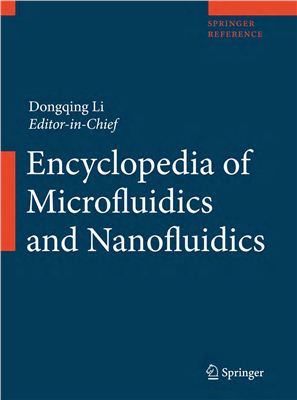Springer Science+Business Media, 2008, 2242 p.
Preface
Microfluidics and nanofluidics are among the most rapidly growing fields of scientific research and technology development. Over the past 15 years, the research activities in these fields have been increasing exponentially as evidenced by the number of published papers in the literature. Microfluidics and nanofluidics not only bring exciting opportunities to study the new phenomena unique to these small scales, but also enable the development of many new and high-impact
technologies from handheld biomedical laboratory (Lab-on-a-Chip) to detection and manipulation of single molecules. While these exciting and inter-disciplinary research fields attract more and more researchers, one major challenge is the lack of a single reference resource providing up-to-date reviews and overviews of various directions in the field of microfluidics and nanofluidics. This is the motivation behind the development of the Encyclopedia of Microfluidics and Nanofluidics. As a comprehensive resource, no single review paper or several books focused on specific topics can replace the role of an Encyclopedia. This is the first Encyclopedia of Microfluidics and Nanofluidics for the scientific community. It covers the fundamentals, latest developments and cutting-edge experimental techniques, including electrical double-layers; optofluidics; DNA lab-on-a-chip; nanosensors; and much more. The high technical quality of the Encyclopedia has been ensured by our Inteational Editorial Board consisting of leading scientists in these fields, and the over 250 experts in microfluidics and nanofluidics. The carefully selected entries deliver relevant and comprehensive information, and are fully illustrated with thousands of diagrams, photos, line art, many in full color. The Encyclopedia provides basic information on all fundamental and applied aspects of microfluidics and nanofluidics by covering two decades of research. It is the only scientific work of its kind in the field of microfluidics and nanofluidics
bringing together core knowledge and the very latest advances. Written for a wide audience with different levels of experience, it provides valuable information to graduate students and scientists who may be new to these fields of microfluidics and nanofluidics while providing up-to-date information to active scientists and experts in the field. This outstanding encyclopedia is an indispensable source for research professionals, technology investors and developers seeking the most up-to-date information on microfluidics and nanofluidics among a wid range of disciplines from science to engineering to medicine. It takes two years of hard work of many people for this Encyclopedia to come to live. I would like to give my sincere thanks the Editorial Board members and many specially invited experts for helping me to review so many manuscripts
to ensure the highest quality. I would like to thank and congratulate all contributing authors. This is your Encyclopedia and you made the great contribution to these fields. Finally, my heartfelt appreciation goes to the colleagues at Springer, Steven Elliot, Oona Schmid, Sylvia Blago, and Simone Giesler-G?llich; without their persistent efforts and hard work
everyday, it is not possible to complete this Encyclopedia.
Dongqing Li Nashville, March 2008
(Editor-in-Chief)
Preface
Microfluidics and nanofluidics are among the most rapidly growing fields of scientific research and technology development. Over the past 15 years, the research activities in these fields have been increasing exponentially as evidenced by the number of published papers in the literature. Microfluidics and nanofluidics not only bring exciting opportunities to study the new phenomena unique to these small scales, but also enable the development of many new and high-impact
technologies from handheld biomedical laboratory (Lab-on-a-Chip) to detection and manipulation of single molecules. While these exciting and inter-disciplinary research fields attract more and more researchers, one major challenge is the lack of a single reference resource providing up-to-date reviews and overviews of various directions in the field of microfluidics and nanofluidics. This is the motivation behind the development of the Encyclopedia of Microfluidics and Nanofluidics. As a comprehensive resource, no single review paper or several books focused on specific topics can replace the role of an Encyclopedia. This is the first Encyclopedia of Microfluidics and Nanofluidics for the scientific community. It covers the fundamentals, latest developments and cutting-edge experimental techniques, including electrical double-layers; optofluidics; DNA lab-on-a-chip; nanosensors; and much more. The high technical quality of the Encyclopedia has been ensured by our Inteational Editorial Board consisting of leading scientists in these fields, and the over 250 experts in microfluidics and nanofluidics. The carefully selected entries deliver relevant and comprehensive information, and are fully illustrated with thousands of diagrams, photos, line art, many in full color. The Encyclopedia provides basic information on all fundamental and applied aspects of microfluidics and nanofluidics by covering two decades of research. It is the only scientific work of its kind in the field of microfluidics and nanofluidics
bringing together core knowledge and the very latest advances. Written for a wide audience with different levels of experience, it provides valuable information to graduate students and scientists who may be new to these fields of microfluidics and nanofluidics while providing up-to-date information to active scientists and experts in the field. This outstanding encyclopedia is an indispensable source for research professionals, technology investors and developers seeking the most up-to-date information on microfluidics and nanofluidics among a wid range of disciplines from science to engineering to medicine. It takes two years of hard work of many people for this Encyclopedia to come to live. I would like to give my sincere thanks the Editorial Board members and many specially invited experts for helping me to review so many manuscripts
to ensure the highest quality. I would like to thank and congratulate all contributing authors. This is your Encyclopedia and you made the great contribution to these fields. Finally, my heartfelt appreciation goes to the colleagues at Springer, Steven Elliot, Oona Schmid, Sylvia Blago, and Simone Giesler-G?llich; without their persistent efforts and hard work
everyday, it is not possible to complete this Encyclopedia.
Dongqing Li Nashville, March 2008
(Editor-in-Chief)

